Analysis of Bearing Safety and Influencing Factors of Supporting Structures of Hydraulic Tunnels in Cold Regions Based on Frost Heave
Abstract
:1. Introduction
2. Establishment of Mechanical Model and Numerical Simulation Model
2.1. Constitutive Model of Support Structure
2.2. Basic Assumptions
- (1)
- Both support structure and surrounding rock are composed of ideal materials with continuous, uniform, and isotropic characteristics.
- (2)
- The phase change occurs in a temperature range around Tm (Tm ± ΔΤ).
- (3)
- After two-dimensional plane analysis on tunnels in cold regions, the problem of the axial length of the tunnel much larger than the cross-sectional size can be regarded as a plane strain problem.
- (4)
- The porosity of the surrounding rock remains unchanged during the freezing process and the surrounding rock is always in a saturated state.
2.3. Temperature Field Control Equation
2.4. Calculation Equation of Frost Heave Force of Frozen Rock Mass
2.5. Establishment of Numerical Simulation Model
3. Comparative Analysis of Engineering Measurement and Calculation Results
3.1. Project Overview
3.2. Comparative Analysis
- (1)
- The freezing depth of the rock is 1.54 m. The temperature field of the rock is distributed in a circular pattern and the temperature become higher with greater distance from the cave wall. The freezing depth in the numerical simulation is consistent in all directions, while the measured freezing depth varies slightly in different directions. The maximum error between the numerical simulation and the measured freezing depth is 4.1% at the waist of the arch. This is mainly due to the fact that the surrounding rock and supporting structure are considered to be homogeneous in all directions in the numerical simulation. Conditions such as joints and seepage are not considered.
- (2)
- The displacement range of the support structure is 9.23~14.85 mm, which first decreases and then increases along the vault to the arch bottom. The frost heave at the vault is 14.85 mm, which is 10.8% higher than the measured value. The frost heave at the arch waist is 10.76 mm, which is 6.5% higher than the measured value. The frost heave at the arch bottom is 11.17 mm, which is 2.5% higher than the measured value. This is because the model assumes that the surrounding rock is always in a saturated state. The displacement value caused by the freezing and expansion of pore water inside the rock mass is larger than the measured value, but the overall error is controllable.
- (3)
- The stress of the support structure is all compressive stress in the range of 11.45~15.96 MPa. The stress first increases and then decreases from the vault to the arch bottom. The maximum compressive stress at the arch waist is 15.96 MPa, and does not reach the compressive strength of the support structure of 18.23 MPa. It can be seen from the cloud diagram of plastic strain that the arch waist section of the support structure enters a plastic state, and the maximum plastic strain is also at the arch waist, which is 1.976 × 10−3 and does not reach the ultimate plastic strain of 3.3 × 10−3.
4. Analysis of Influencing Factors on Mechanical Characteristics of Support Structures
4.1. Influence of Thermal Expansion Coefficient on the Force of Support Structure
4.2. Influence of Temperature Difference on the Force of Support Structure
4.3. Influence of Surrounding Rock Porosity on Supporting Structure Stress
5. Conclusions
- (1)
- The measured monthly average temperature of the project, −16.3 °C, is used for the numerical calculation. The results show that the maximum compressive stress of the supporting structure is located at the arch waist, which is 15.96 MPa. Although it does not exceed the compressive strength of the concrete, a plastic zone is created at the arch waist. Therefore, attention should be paid to strengthening the compressive measures at the arch waist during the secondary support construction to prevent the arch waist from cracking due to compressive deformation. The overall displacement trend of the supporting structure is inward contraction. The displacement of the top of the arch sinking is the largest, at 14.85 mm. The displacement of the bottom of the arch is in the middle of the range, at 11.17 mm. The shrinkage displacement of the arch waist is the smallest, at 10.76 mm. During the construction of the support, attention should be paid to strengthening the displacement control measures at the top of the arch.
- (2)
- After analyzing the coefficient of thermal expansion, temperature difference, and porosity of the surrounding rock, three factors affecting tunnel frost heave and force characteristics of cold regions can be obtained as follows. When other parameters are constant, the larger the thermal expansion coefficient, the larger the frost heave pressure of the rock mass, the larger the heave rate of the supporting structure, the larger the stress value and plastic strain at the haunch, and the more unfavorable the bearing safety. Moreover, a greater temperature difference leads directly to an increase in the freezing depth, meaning that the frost heave pressure also increases, and the displacement of the supporting structure gradually increases, leading to more unfavorable load-bearing safety. When the surrounding rock porosity is larger, the higher the water content of the rock mass, the greater the amount of expansion generated by the freezing, the greater the frost heave pressure, the greater the displacement and stress–strain value of the supporting structure, and the more unfavorable the bearing safety.
- (3)
- By increasing the strength of the supporting structure, actively or passively insulating the structure and installing effective drainage measures, the frost heave rate of the supporting structure can be reduced, the temperature difference reduced and the water content reduced, thus effectively enhancing the load-bearing safety of the supporting structure.
- (4)
- The accuracy of the simulation results of the numerical model established by using the mechanical model in this paper is good, and the agreement between the engineering measured results and the numerical calculation results is high. When assessing the safety of other tunnel supporting structures in similar cold regions, the mechanical model and numerical simulation model in this paper can be used.
Author Contributions
Funding
Data Availability Statement
Conflicts of Interest
References
- Ma, X.L.; Dong, X.P. The frost damage mechanism and countermeasures for tunnels in cold regions. Chin. J. Undergr. Space Eng. 2014, 10, 1996–1999. [Google Scholar]
- Lv, K.C.; Ji, Z.; Ma, C.C.; Xu, P. Causes of tunnel frost damages in cold region and several new technologies to prevent them. Highway 2012, 57, 297–301. [Google Scholar]
- Liu, W.W.; Feng, Q.; Fu, S.G.; Wang, C.X. Elasto-plastic solution for cold-regional tunnels considering the compound effect of non-uniform frost heave, supporting strength and supporting time. Tunn. Undergr. Space Technol. 2018, 82, 293–302. [Google Scholar] [CrossRef]
- An, P.; Xing, Y.C.; Wang, S.H.; Cheng, D.W. Cause analysis of exfoliation of side walls for Karez tunnel and seepage control reinforcement. Trans. Chin. Soc. Agric. Eng. 2018, 34, 138–144. [Google Scholar]
- Jiang, H.B.; Zhai, D.S.; Xiang, P.F.; Wei, G. Research on frost heaving characteristics of hydraulic tunnels’ wall rock in cold regions based on phase transition and water-heat-stress coupling. Buildings 2022, 12, 1026. [Google Scholar] [CrossRef]
- Xu, P.; Zhang, J.H.; Zhang, D.B.; Xiao, C. Elastic-plastic analysis of stability of cold-region circular tunnels subjected to frost heaving force. China Saf. Sci. J. 2022, 32, 127–133. [Google Scholar]
- Li, Y. Research on the Anti-freeze Critical and Early Maturity of Negative Temperature Concrete in −10 °C Condition. Master’s Thesis, Shijiazhuang Tiedao University, Shijiazhuang, China, 2015. [Google Scholar]
- Dai, J.P.; Wang, Q.C.; Qu, S.; Duan, Y.; Xie, Z.G. Strength prediction model of low temperature curing concrete based on maturity theory. J. Mater. Sci. Eng. 2018, 36, 263–267. [Google Scholar]
- Li, W.; Zhang, D.M.; Ye, F.; Wang, S.Y.; Liang, X.M. Study on influence of freeze-thaw cycles on thermal conductivity of tunnel lining concrete in seasonal freezing zone. Tunn. Constr. 2020, 40, 1725–1732. [Google Scholar]
- Zhang, D.H.; Wang, M.S.; Tan, Z.S.; Kong, H.; Cui, J. Effect of frost heaving on tunnel surpporting systems of Fenghuoshan railway tunnel. Chin. J. Geotech. Eng. 2003, 25, 571–573. [Google Scholar]
- Feng, Q.; Fu, S.G.; Wang, C.X.; Liu, W.W.; Wang, Y.; Qiao, W.G. Analytical elasto-plastic solution for frost force of cold-region tunnels considering anisotropic frost heave in the surrounding rock. KSCE J. Civ. Eng. 2019, 23, 3831–3842. [Google Scholar] [CrossRef]
- Lv, Z.T.; Xia, C.C.; Wang, Y.S.; Luo, J. Analytical elasto-plastic solution of frost heaving force in cold region tunnels considering transversely isotropic frost heave of surrounding rock. Cold Reg. Sci. Technol. 2019, 163, 87–97. [Google Scholar] [CrossRef]
- Lv, Z.T.; Xia, C.C.; Liu, W.P. Analytical solution of frost heaving force and stress distribution in cold region tunnels under non-axisymmetric stress and transversely isotropic frost heave of surrounding rock. Cold Reg. Sci. Technol. 2020, 178, 103–117. [Google Scholar]
- Peng, X.L.; Wang, H.J.; Yang, F.C.; Jiang, H.B.; Li, C.C. Analysis of surrounding-rock frost-heaving characteristics of diversion tunnel in cold region: A case study on diversion tunnel project of Bulunkou hydropower station in Xinjiang. Tunn. Constr. 2021, 41, 232–239. [Google Scholar]
- Zeng, Y.; Hu, L.M. Calculation transformation and calibration of ABAQUS concrete plastic damage constitutive model. Water Resour. Power 2019, 37, 106–109. [Google Scholar]
- Qi, H.; Li, Y.G.; Lv, X.L. Study of variables of elastic plastic damage model and its engineering application. J. Zhejiang Univ. 2015, 49, 547–554+563. [Google Scholar]
- Yu, Q.Y.; Zhang, C.; Liu, C. Analysis and evaluation of secondary lining thickness detection and safety of high-speed railway tunnel. Subgrade Eng. 2019, 202, 214–217+227. [Google Scholar]
- Zhang, Y.W.; Li, Y.Y.; Xie, Y.L.; Zan, W.B. On frost-heave calculation model based on a broken freeze-thaw circle and its influential factors. Mod. Tunn. Technol. 2017, 54, 93–102. [Google Scholar]
- GB50010-2010; Code for Design of Concrete Structures. China Architecture & Building Press: Beijing, China, 2011.
- Tan, X.J. A Dissertation for the Doctoral Degree of geotechnical engineering in the Graduate School of Chinese Academy of Sciences. Doctor’s Thesis, Graduate School of Chinese Academy of Sciences, Wuhan, China, 2010. [Google Scholar]
- Bonacina, C.; Comini, G.; Fasano, A.; Primicerio, M. Numerical solution of phase change problems. Int. J. Heat Mass Transf. 1973, 16, 1825–1832. [Google Scholar] [CrossRef]
- Zhou, J.Z.; Wei, C.F.; Lai, Y.M.; Wei, H.Z.; Tian, H.H. Application of the generalized clapeyron equation to freezing point depression and unfrozen water content. Water Resour. Res. 2018, 54, 9412–9431. [Google Scholar] [CrossRef]
- Liu, Q.S.; Huang, S.B.; Kang, Y.S.; Pan, Y.; Cui, X.Z. Numerical and theoretical studies on frost heaving pressure in a single fracture of frozen rock mass under low temperature. Chin. J. Geotech. Eng. 2015, 37, 1572–1580. [Google Scholar]
- Zheng, Y.R.; Zhu, H.H. The Stability Analysis and Design Theory of Surrounding Rock of Underground Engineering, 1st ed.; China Communications Press: Beijing, China, 2012; pp. 120–146. [Google Scholar]
- Zhang, Y.W.; Xie, Y.L.; Li, Y.Y.; Lai, J.X. A frost heave model based on space-time distribution of temperature field in cold region tunnels. Rock Soil Mech. 2018, 39, 1625–1632. [Google Scholar]
- Yang, Q.; Rong, C.X. Distribution of the freezing temperature field and formation law of the frost heaving force of a deep expansive clay layer. J. Glaciol. Geocryol. 2020, 42, 878–888. [Google Scholar]
- Wang, Z.Z.; Zhang, C.Q.; Sha, J.D. A finite element analysis of the coaction between frozen ground and spread wall foundation. Acta Univ. Agric. Boreali Occident. 1998, 26, 12–17. [Google Scholar]

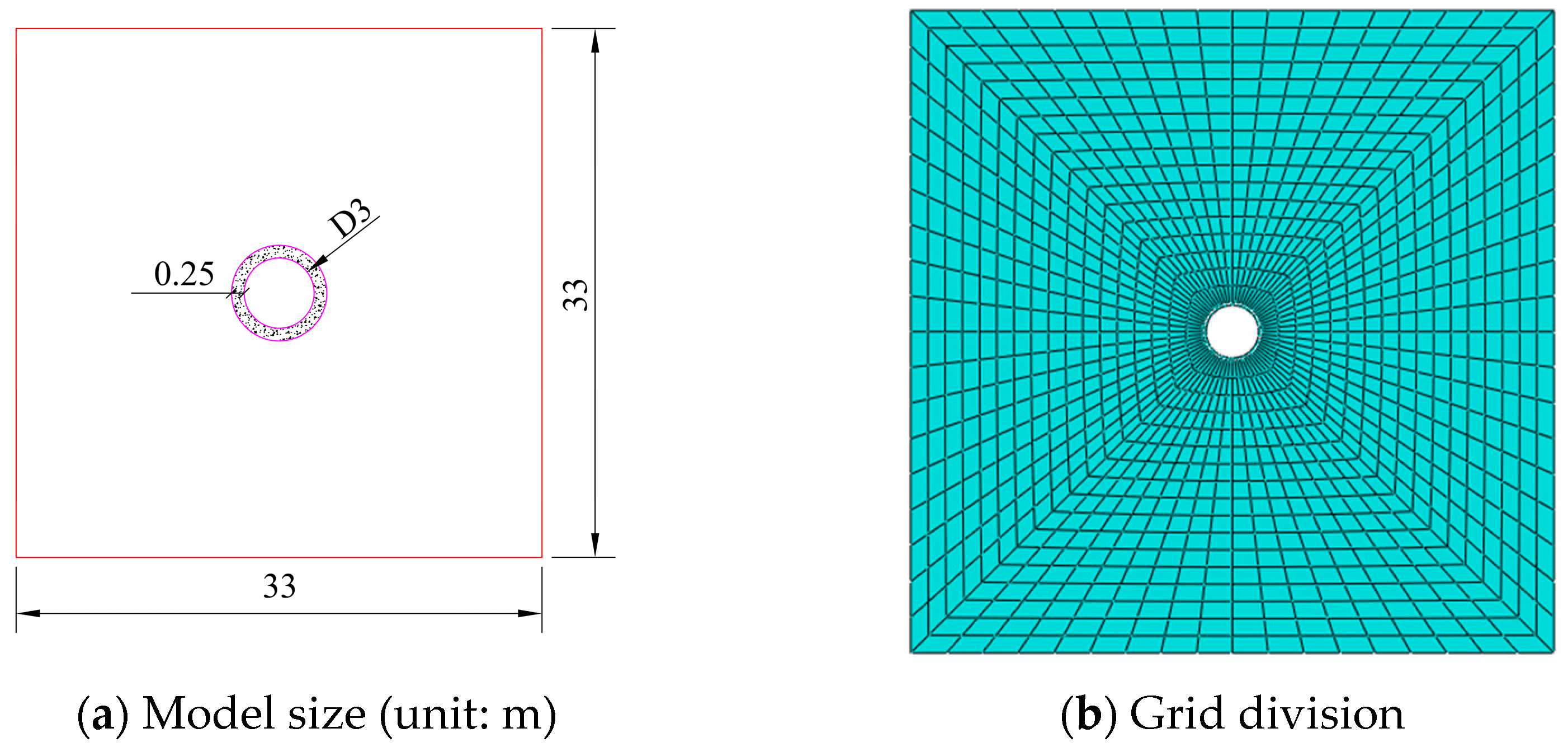
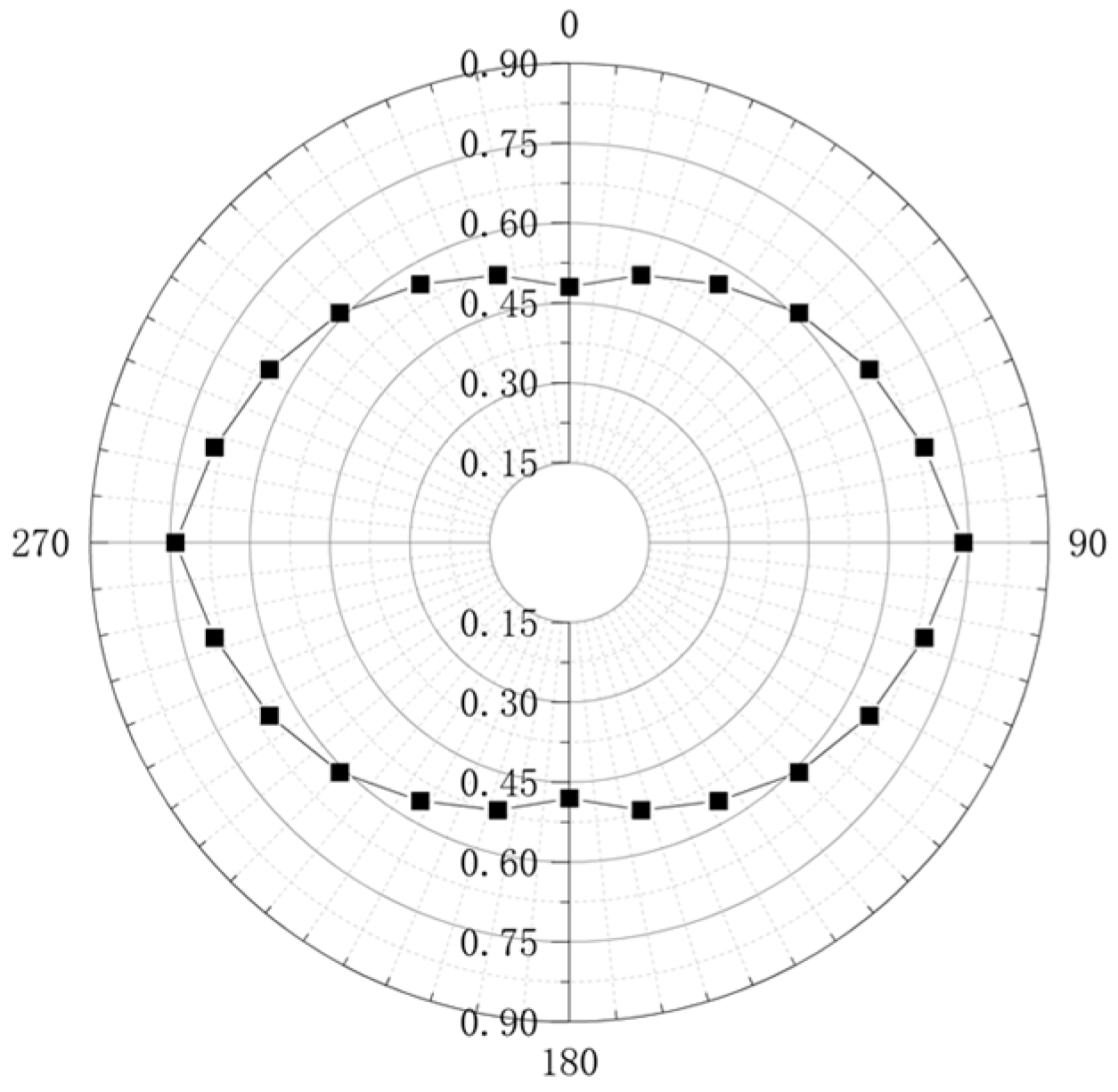

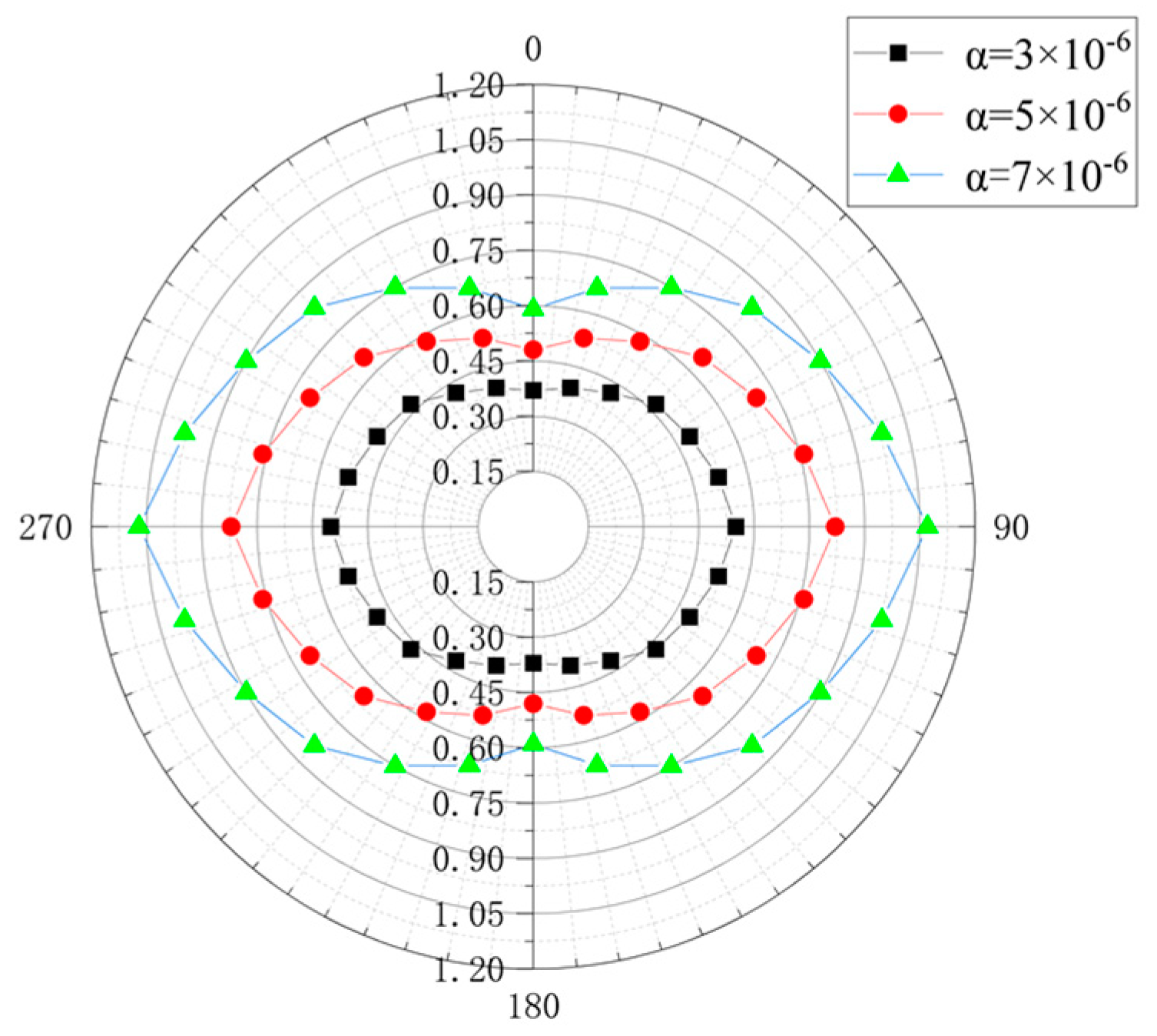
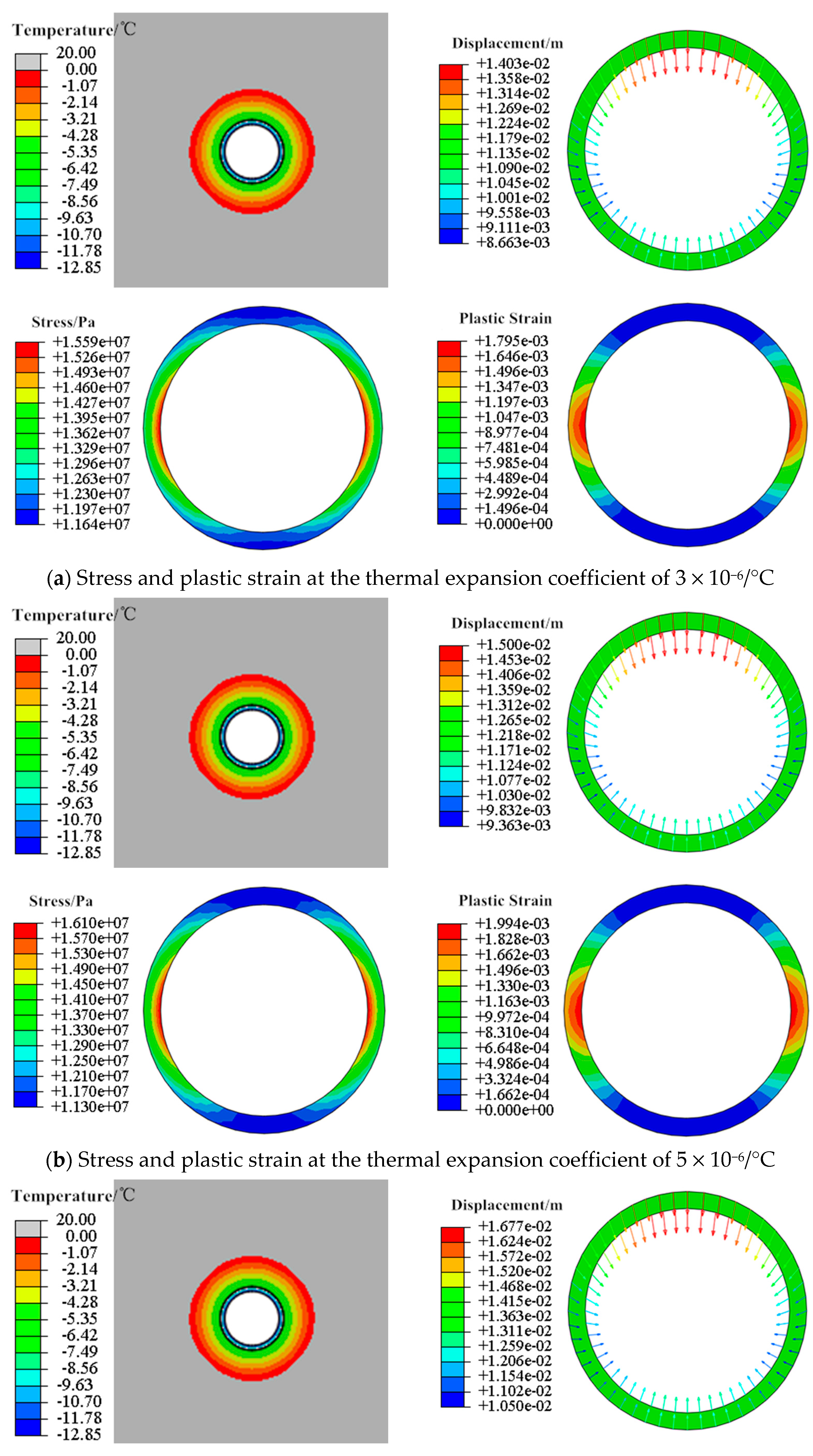
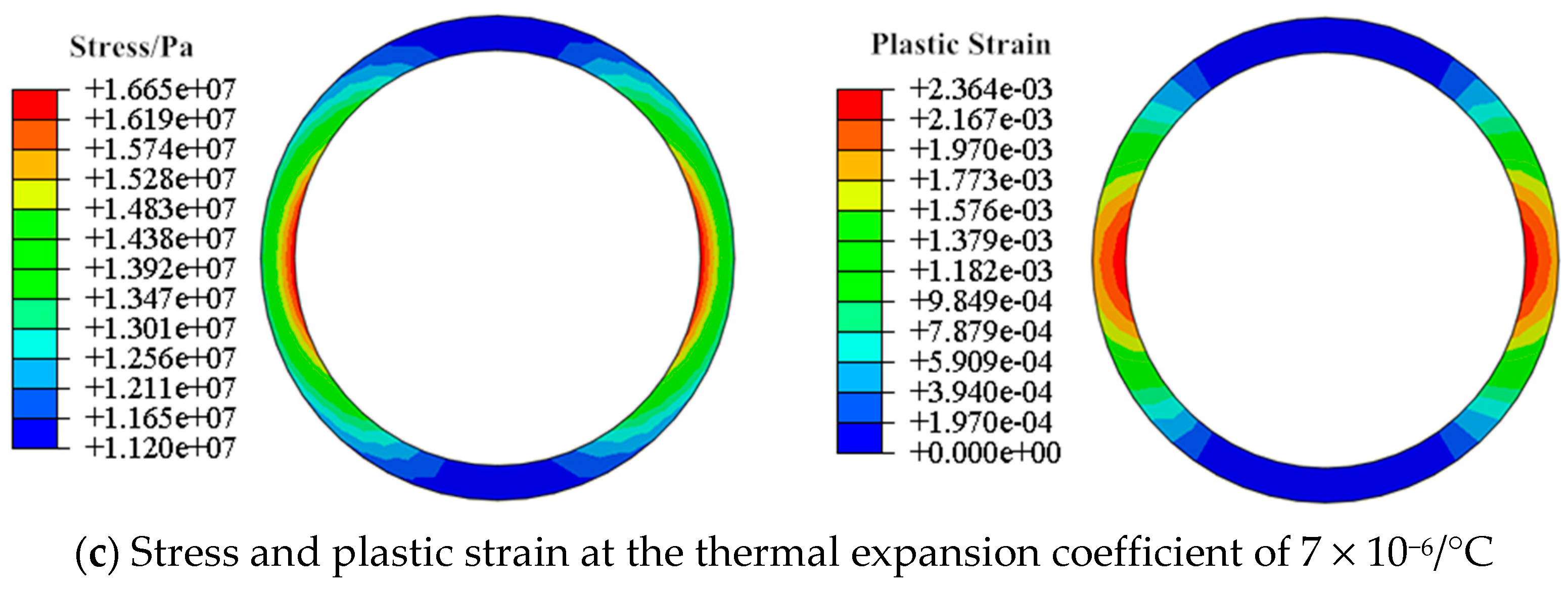
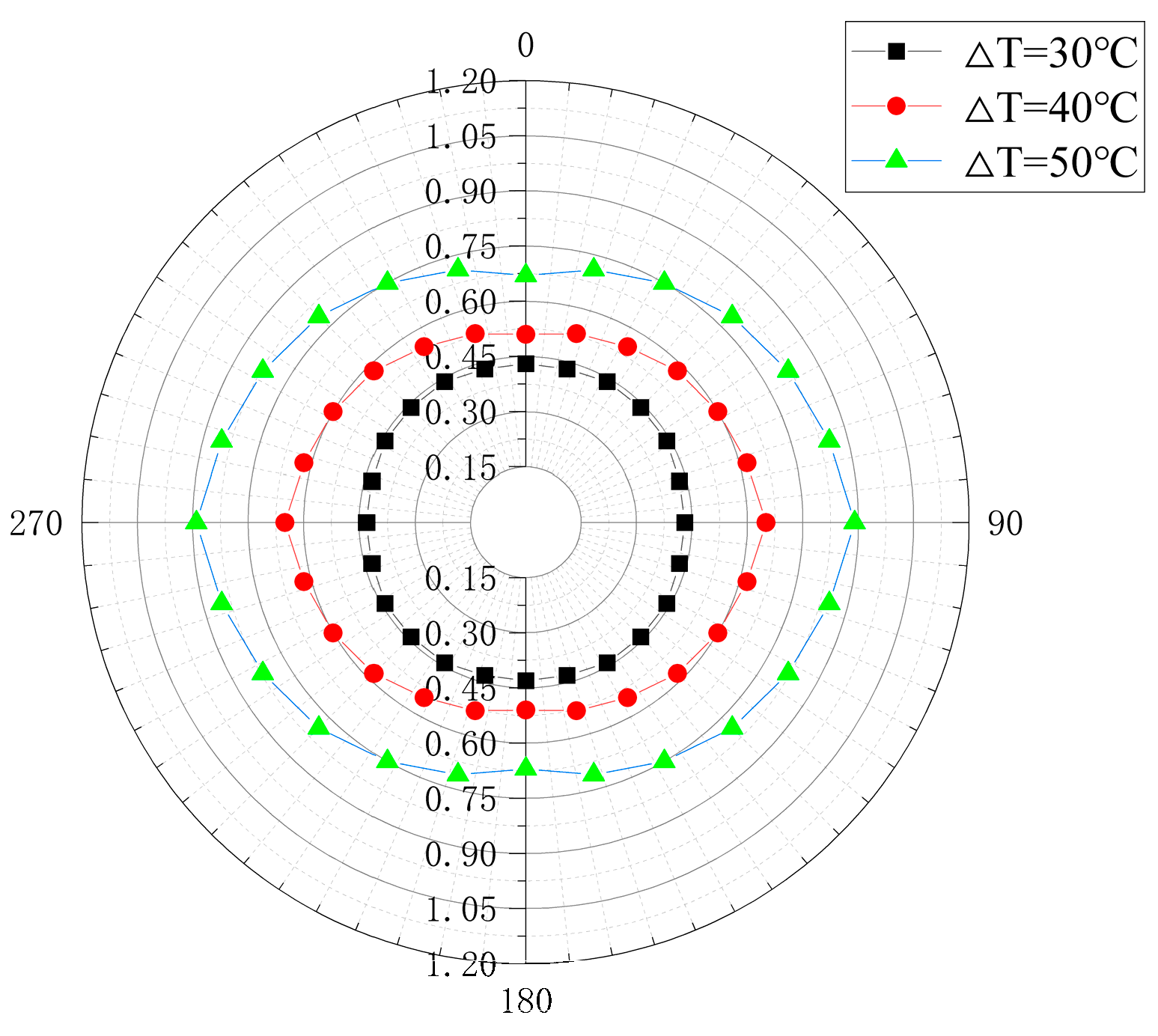

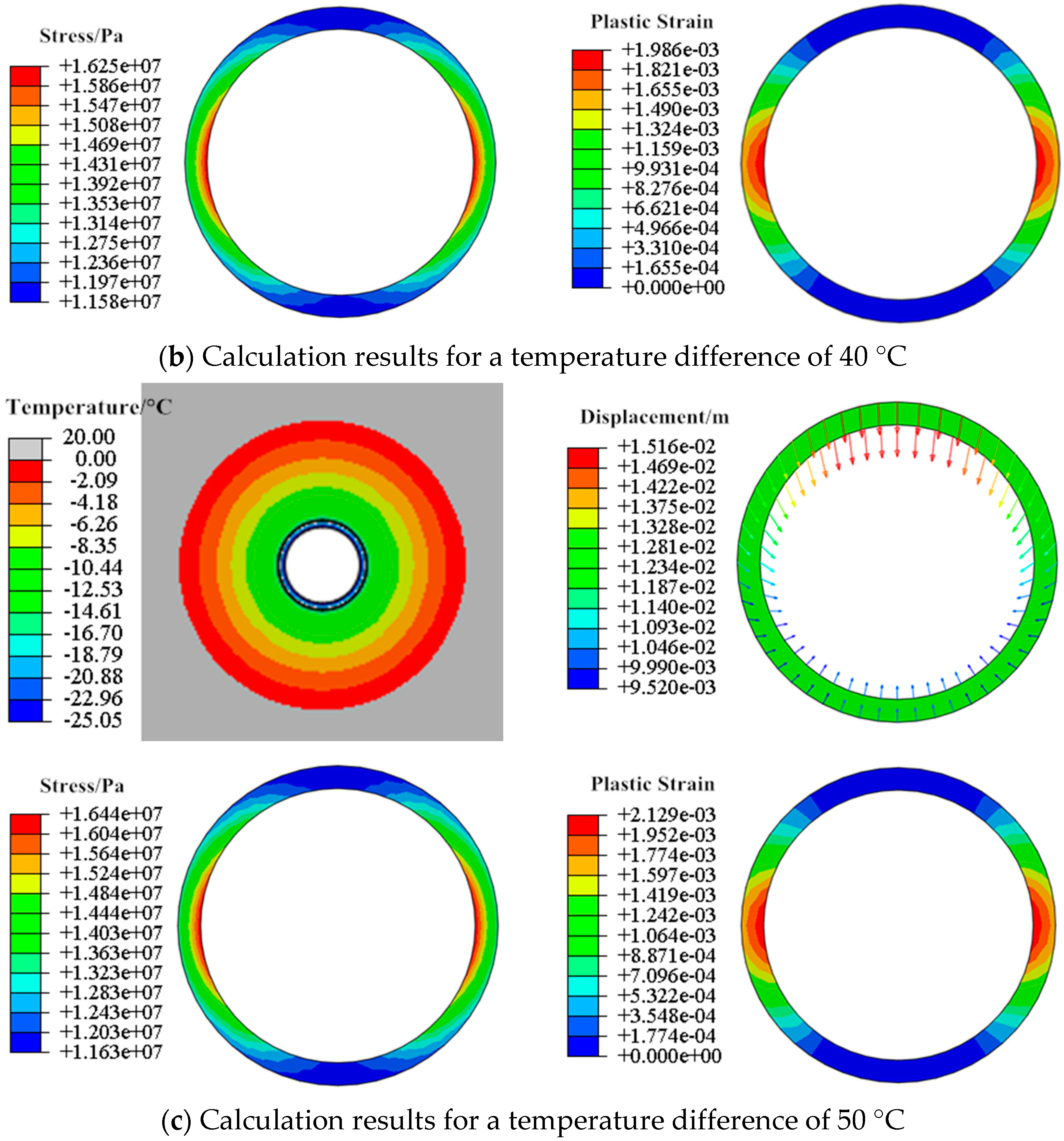



| Materials | Density/(kg/m3) | Elastic Modulus/GPa | Poisson’s Ratio | Thermal Conductivity/(w/(m·°C) | Specific Heat Capacity/(J/(kg·°C) | Cohesion/MPa | Internal Friction Angle /(°) | Porosity | Ultimate Plastic Strain |
|---|---|---|---|---|---|---|---|---|---|
| Support structure | 2400 | 30 | 0.2 | 1.8 | 960 | 3.18 | 60.3 | 0.16 | 3.3 × 10−3 |
| frozen rock | 2156 | 4 | 0.29 | 3.5 | 1150 | 0.61 | 36 | 0.21 | 3 × 10−3 |
| unfrozen rock | 2156 | 3.2 | 0.33 | 2.9 | 1350 | 0.68 | 32 | 0.21 | 3 × 10−3 |
| Section | Monthly Average Temperature T/°C | Maximum Freezing Depth/m | Freeze Displacement ∆h/cm | Frost Heave Rate η/% | Frost Heave Force p/MPa |
|---|---|---|---|---|---|
| Vault | −16.3 | 1.56 | 13.4 | 8.59 | 0.44 |
| Arch waist | 1.48 | 10.1 | 6.82 | 0.68 | |
| Arch bottom | 1.51 | 10.9 | 7.22 | 0.41 |
Disclaimer/Publisher’s Note: The statements, opinions and data contained in all publications are solely those of the individual author(s) and contributor(s) and not of MDPI and/or the editor(s). MDPI and/or the editor(s) disclaim responsibility for any injury to people or property resulting from any ideas, methods, instructions or products referred to in the content. |
© 2023 by the authors. Licensee MDPI, Basel, Switzerland. This article is an open access article distributed under the terms and conditions of the Creative Commons Attribution (CC BY) license (https://creativecommons.org/licenses/by/4.0/).
Share and Cite
Jiang, H.; Zhai, D.; Shi, K.; Xiang, P. Analysis of Bearing Safety and Influencing Factors of Supporting Structures of Hydraulic Tunnels in Cold Regions Based on Frost Heave. Buildings 2023, 13, 544. https://doi.org/10.3390/buildings13020544
Jiang H, Zhai D, Shi K, Xiang P. Analysis of Bearing Safety and Influencing Factors of Supporting Structures of Hydraulic Tunnels in Cold Regions Based on Frost Heave. Buildings. 2023; 13(2):544. https://doi.org/10.3390/buildings13020544
Chicago/Turabian StyleJiang, Haibo, Dongsen Zhai, Kebin Shi, and Pengfei Xiang. 2023. "Analysis of Bearing Safety and Influencing Factors of Supporting Structures of Hydraulic Tunnels in Cold Regions Based on Frost Heave" Buildings 13, no. 2: 544. https://doi.org/10.3390/buildings13020544
APA StyleJiang, H., Zhai, D., Shi, K., & Xiang, P. (2023). Analysis of Bearing Safety and Influencing Factors of Supporting Structures of Hydraulic Tunnels in Cold Regions Based on Frost Heave. Buildings, 13(2), 544. https://doi.org/10.3390/buildings13020544





